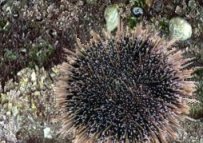
Sea urchins (kina) are members of a large group of marine invertebrates that are a spiny skinned animals group, found in rock pools, and rocky reefs all around New Zealand's coasts. Included within this group of invertebrates would be starfish, sea cucumbers, and brittle stars etc.
All sea urchins have a hard calcareous shell, composed of calcitic plates. These plates are firmly bound together to form a solid skeleton, called the test. Their skin is covered and armed with spines. These spines are used for movement, protection, and for trapping drifting algae for food. Between the spines, are tube feet that are used in food capture, locomotion, and for holding on to the rocks.
The tubed feet are also used for getting oxygen into the body and removing waste gases such as carbon dioxide.
The mouth is located on the underside. It consists of a complex array of skeletal plates, and teeth. The mouth leads to the digestive tract which empties through the anus located on the top.
Five threds or coils of roe are the most prominent structures in the internal cavity of sea urchins. Between theise threds of roe are gill like structures which are part of the water vascular system, important in movement, respiration, and food gathering. The gut is dark and often filled with partialy digested plant materia.
Sea urchins usually have seperate sexes. The females release up to several million eggs into the sea where fertilization takes place. After a short planktonic existence in the upper surface waters and normally several weeks, the larvae settle and change form to the more familiar form.
Sea urchins feed mainly on broken kelp. I have sometimes noted areas that were totally covered with kelp and crayfish and the one or two urchins around, and a year later there was no kelp no crayfish but dozens of urchins. The whole area had been stripped of life. If the preferred food is absent, they will eat other algae, dead fish, lobster bait, and small animals.
The predators for urchins would be starfishes, crabs, crayfish, and some fish.